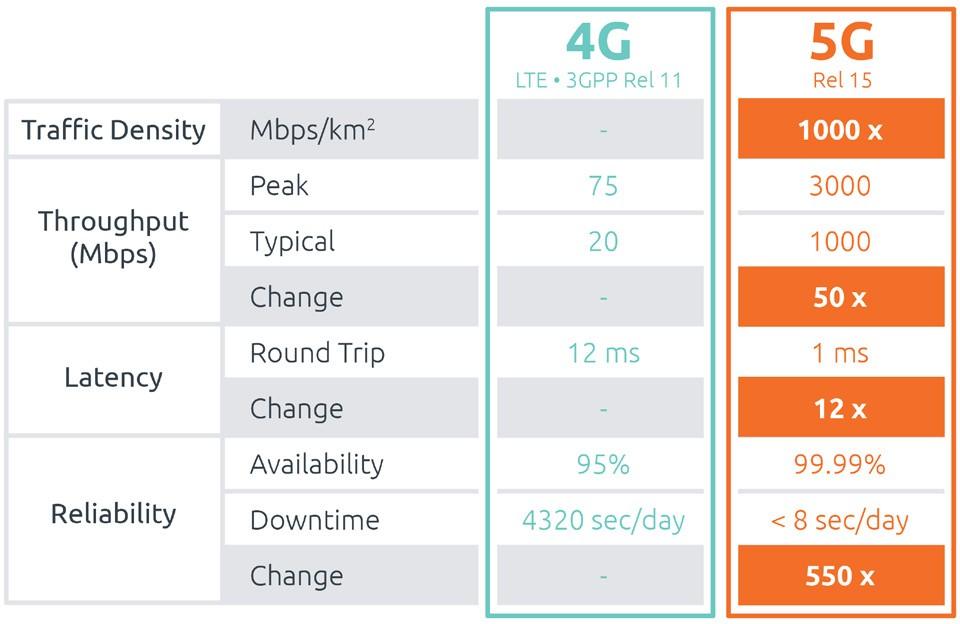Competitive service providers today know that delivering an excellent customer experience end-to-end is the key factor in determining success. It is also at the heart of today’s network evolution.
A network-centric model for service deployment and performance measurement is no longer good enough. Customers now have higher expectations on service and application quality, so developing a dynamic, service-centric network that puts quality of experience first and adapts to ensure service quality in real time, will be critical to win customers and prevent churn.
5G performance management
Service providers are building and implementing strategies for migration to 5G-based services and architectures in a gradual fashion. This means 4G and its variants will be around for a while yet, and service providers will be handling performance management in a hybrid environment.
5G drivers
Early adopters expect to use 5G to boost capacity and provide dynamic, broadband-based services to their customers, while also leveraging the ability to carry their own network traffic to areas that are not cost-effective for fiber deployment.
However, the number one driver for revenue-generating 5G use cases is the architecture’s ability to deliver extremely high quality and low latency services. Latency improvements needed for 5G are orders of magnitude beyond what’s available today.

5G complexities
5G comes added complexity. Whether logical or new physical links, the paths that need to be monitored will double with 5G, and small cells will also dramatically increase the number of connections beyond macro backhaul connectivity.
- Backhaul connections
5G latency and reliability demands require direct inter-tower communication links, effectively doubling the number of backhaul connections, as well as significantly increasing the volume and variety of data carried on them. The management complexity of the backhaul network increases with the need to to not only monitor network performance on links to the core, but also to monitor the links between towers. 5G requirements mean that measuring all these links can only be done with very granular, precise performance management. - Network slicing
As networks are opened to third parties and their myriad and diverse applications (each with different network demands), ‘network slicing’ makes it possible to automatically and dynamically allocate resources required to meet SLAs. - Customer experience
The service layer—where the as-yet-unimaginable variety of applications reside that will take advantage of 5G’s capabilities—represents a whole new management challenge, especially because 5G is sold on the premise of “a better user experience.” Insight into network and application performance is only as good as the data collected for analysis. Often, ‘garbage data’ leads to a perception that the network is working well, which differs significantly from the actual user experience. Understanding the impact of performance issues on the end customer experience is a non-negotiable aspect of being 5G-ready.
Adaptive 5G networks
This is, of course, easier said than done.
5G application performance will depend on the interplay and orchestration of dozens of microservices, which must be efficiently deployed and dispersed over ubiquitous locations on demand and through open APIs. The mobile network and service path must maintain a cohesive, integrated compute experience offering the resilience and scalability of ‘traditional’ service networks.
These demands exceed human capabilities – ultra-fast orchestration that can react within microseconds to dynamic changes in the network will be critical. Machine learning and artificial intelligence will play a key role in this orchestration by self-learning from network KPIs to rapidly establish what constitutes “normal” or acceptable impairments, relative to impairments that are affecting end-user applications and quality of experience.
For 5G mobile networks to properly succeed, an integrated, microservice-based nervous system will need to live within the network. This system will:
- Provide the sensory feedback needed to maintain performance and stability.
- Ensure every application can meet its required level of performance.
- Illuminate service transactions occurring locally, in the cloud, and on user devices.
- Ensure the correct network slices are selected for the correct types of services
Imagine a distributed, passive network and application performance monitoring mesh run at the multi-access edge and complemented by core visibility. Perhaps this is your answer.
Skylight is a performance management backbone for your 5G network
5G backhaul performance needs to be evaluated in terms of the relationship between a particular service’s sensitivity to latency and the availability of network resources to fulfill that latency requirement. Monitoring this relationship must be done at a microsecond level of granularity to gain meaningful insights that can be acted upon to protect or fix the all-important user experience. Accedian is unique in providing this capability for both physical and virtual infrastructure.
Skylight answers the challenge of how to monitor increasingly dynamic and highly complex networks to allow service providers, as well as enterprises, to dramatically improve visibility and drive end-to-end network and application performance. Fully virtualized network and application performance management is the only viable solution to ensure unparalleled end-user experiences in the evolved 5G world.
The Skylight solution architecture — including analytics, orchestrator, sensors, performance elements, and performance modules— deliver complete 5G backhaul performance assurance, enabling end-to-end SLAs for the next generation of mobile.

 Improved delivery, better visibility: How Accedian and VMware are working together to help CSPs navigate the 5G world
Improved delivery, better visibility: How Accedian and VMware are working together to help CSPs navigate the 5G world
 Adding a new dimension of visibility to the Cisco Full-Stack Observability portfolio with Accedian Skylight
Adding a new dimension of visibility to the Cisco Full-Stack Observability portfolio with Accedian Skylight